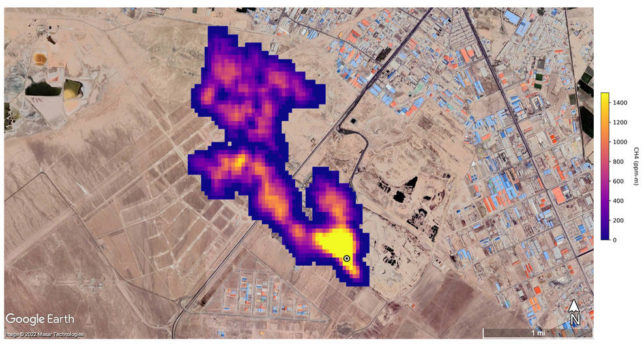
More Than 50 Global Methane 'Super-Emitter' Zones Discovered, Says NASA
Share
In a study of how dust affects climate, NASA scientists discovered that more than 50 spots around the world emit large amounts of methane, a development that could help combat the potent greenhouse gas. "Reining in methane emissions is key to limiting global warming," NASA Administrator Bill Nelson said in a press release on Tuesday. "This exciting new development will not only help researchers better pinpoint where methane leaks are coming from, but also provide insight on how they can be addressed – quickly."
NASA's Earth Surface Mineral Dust Source Investigation (EMIT) aims to understand how airborne dust affects climate. As well as being able to detect methane, EMIT, which was installed on the International Space Station in July, can also be used to monitor small areas like a soccer field.

A huge plume of the potent greenhouse gas methane is shown here spewing from oil and gas infrastructure in Turkmenistan. NASA has uncovered more than 50 such sites using image technology installed on the International Space Station. Image courtesy of NASA.
In Central Asia, the Middle East, and the southwestern United States, NASA has identified more than 50 "super-emitters" of methane gas. Most of them are connected to the fossil fuel, waste or agriculture sectors. Kate Calvin, NASA's chief scientist and senior climate advisor, said EMIT's "additional methane-detecting capability offers a remarkable opportunity to measure and monitor greenhouse gases that contribute to climate change."
Global temperatures have risen by approximately 30 percent as a result of methane emissions.
Although it is far less abundant in the atmosphere than CO2, it is 28 times more powerful as a greenhouse gas. Methane lingers in the atmosphere for only a decade, compared to hundreds or thousands of years for CO2. This means a sharp reduction in emissions could shave several tenths of a degree Celsius off of projected global warming by mid-century, helping keep alive the Paris Agreement goal of capping Earth's average temperature increase to 1.5 degrees Celsius, according to the UN Environment Programme (UNEP).
"EMIT will potentially find hundreds of super-emitters – some of them previously spotted through air-, space-, or ground-based measurement, and others that were unknown," NASA said. Andrew Thorpe, a research technologist at the Jet Propulsion Laboratory leading the EMIT methane effort, said some of the methane plumes detected by EMIT are among the largest ever seen. "What we've found in a just a short time already exceeds our expectations," Thorpe said.
NASA said a methane plume about 3.3 kilometers long was detected southeast of Carlsbad, New Mexico, in the Permian Basin, one of the largest oilfields in the world. It said 12 plumes from oil and gas infrastructure were identified in Turkmenistan, east of the Caspian Sea port city of Hazar.
A methane plume at least 4.8 kilometres long was detected south of Tehran from a major waste-processing complex, NASA said.
You’ve come this far…
Why not venture a little further into A.S.S. - our exclusive Australian Space Society.
And keep thrusting Australia into the deep unknown…
#Space_Aus




